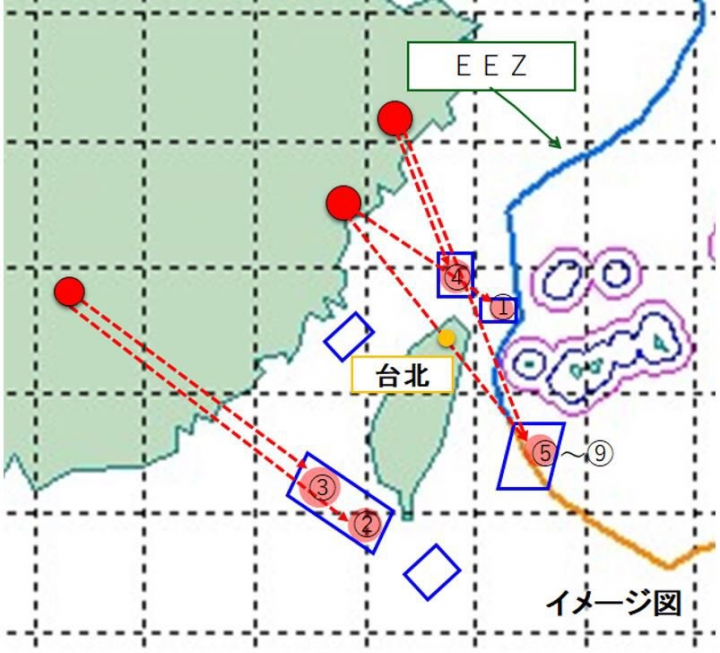
Taipei, Aug. 5 (CNA) The Ministry of National Defense (MND) remained less than forthcoming on whether missiles launched Thursday by China flew over Taiwan, but said it clearly followed the trajectory and landing site of the missiles and saw that they posed no danger to Taiwan.
The Chinese People's Liberation Army (PLA) fired 11 Dongfeng ballistic missiles in the general direction of Taiwan from 1:56 p.m. to 4:08 p.m. Thursday, the first day of four days of live-fire military drills in six maritime areas around the island.
Taiwan's MND immediately confirmed the missile launches Thursday afternoon, saying the missiles landed in waters near northern, southern and eastern parts of the country.
On Thursday night, however, Japan's Defense Ministry reported that of nine missiles launched by the PLA from 1:56 p.m. to 3:08 p.m. (Taiwan time), five landed in waters in Japan's exclusive economic zone, and four of the five flew over Taiwan.
In response to the Japanese Defense Ministry statement, Taiwan's MND would not confirm whether the missiles were fired over Taiwan.
It would only say initially that the military was using various early-warning and monitoring mechanisms to track missiles fired by the PLA and had activated related defense systems.
Later at 11:35 p.m., the MND issued another statement in which it explained why it did not describe the paths of the missiles launched by PLA as the Japanese Defense Ministry did.
After a ballistic missile is launched into space, its main path is outside the atmosphere before it lands, which means that the missile poses no dangers to the vast ground area it flies over during the trajectory, the MND said.
Still falling short of confirming whether there were four missiles that actually flew over Taiwan, the MND said its statement was in response to "concerns" over the missiles "flying over Taipei."
The MND also defended its decision not to set off air raid alerts, saying in the statement that its surveillance and reconnaissance system accurately grasped the missiles' trajectory and felt they posed no harm to Taiwan proper.
Another reason for not releasing more information, such as on the flight paths of the PLA-launched missiles, was to protect the military's intelligence, surveillance and reconnaissance capabilities, the statement said.
Meanwhile, the Army's Kinmen Defense Command said at 11:10 p.m. Thursday that four PLA drones were spotted that night flying over the waters surrounding Lieyu Islet (烈嶼) and Beiding Islet (北碇島) in Kinmen County.
Vessels from China are prohibited from entering there without prior permission from Taiwan's authorities as stipulated under the Regulations Governing the Approval and Administration of Direct Cross-Strait Sea Transport Between the Taiwan Area and the Mainland Area.
Army units in Kinmen fired warning flares on three occasions at the four PLA drones and maintained a high level of surveillance and vigilance, the Kinmen Defense Command said.
Prior to that, a PLA drone was detected flying over the main island of Kinmen County and Beiding islet between 9 p.m. and 10 p.m. Wednesday night, the second time in a week that a PLA drone had been spotted in the vicinity of one of Taiwan's offshore counties, the statement said.
Kinmen, alternatively known as Quemoy, is a group of islands administered by the Republic of China (Taiwan) that are located roughly 10 kilometers east of the city of Xiamen in China's Fujian Province.
Army units stationed on the tiny Dongyin (東引) Island, part of the Matsu archipelago under Taiwan's Lienchiang County, reported a similar incident on July 28.
The launching of the missiles and incursions by PLA drones came after U.S. House of Representatives Speaker Nancy Pelosi concluded a 19-hour visit to Taiwan on Wednesday, the first by a sitting U.S. House speaker since 1997.